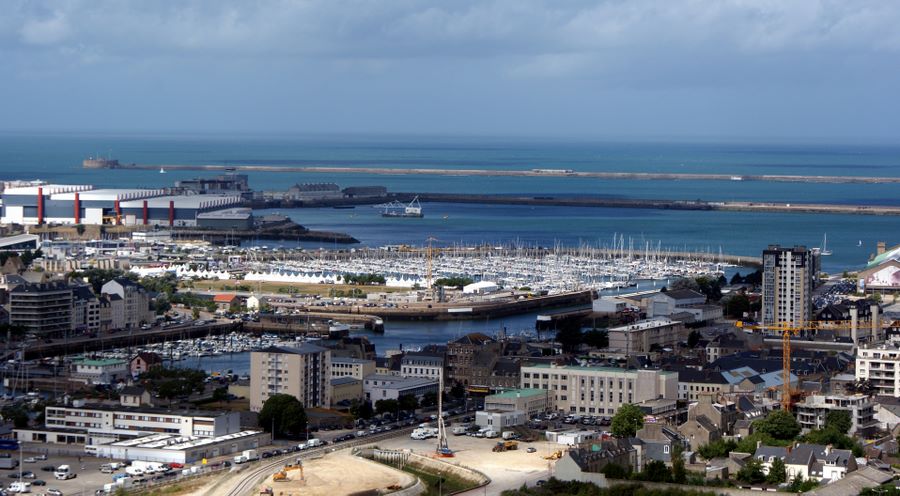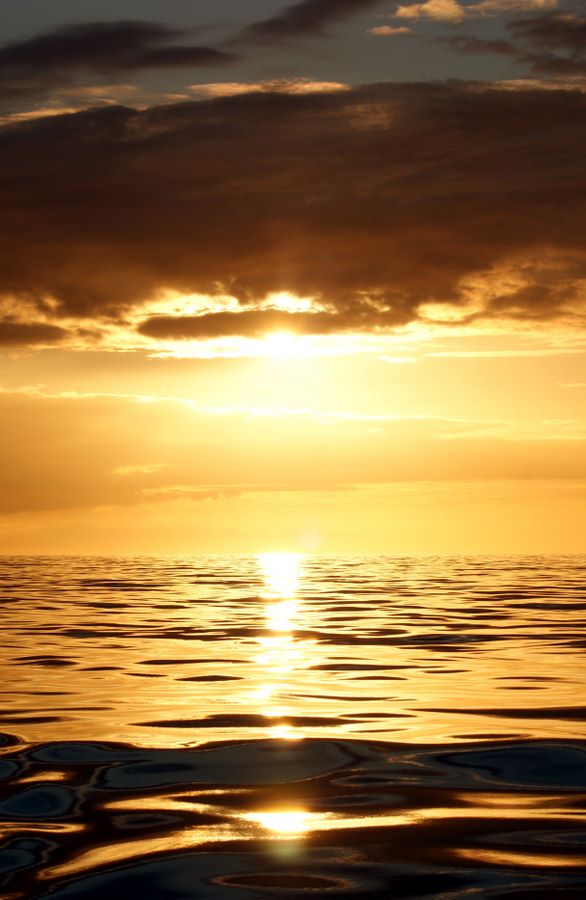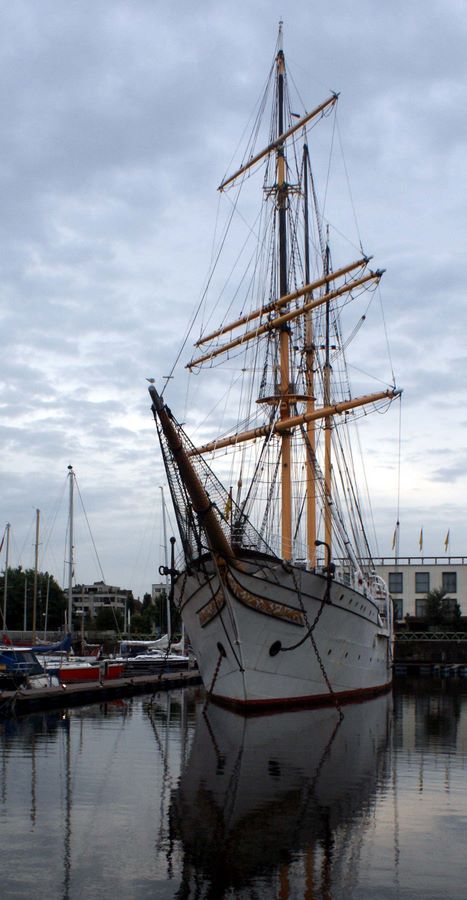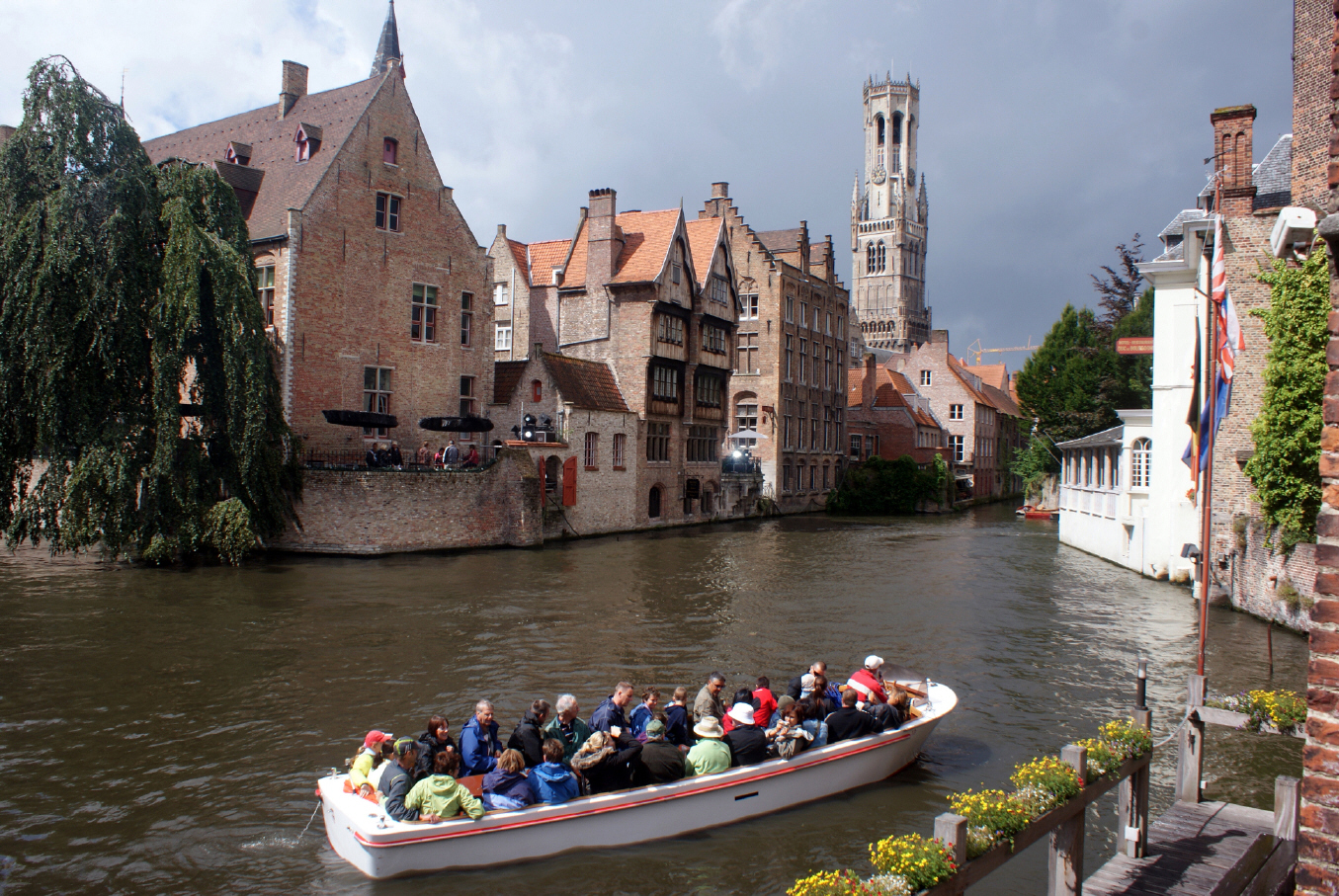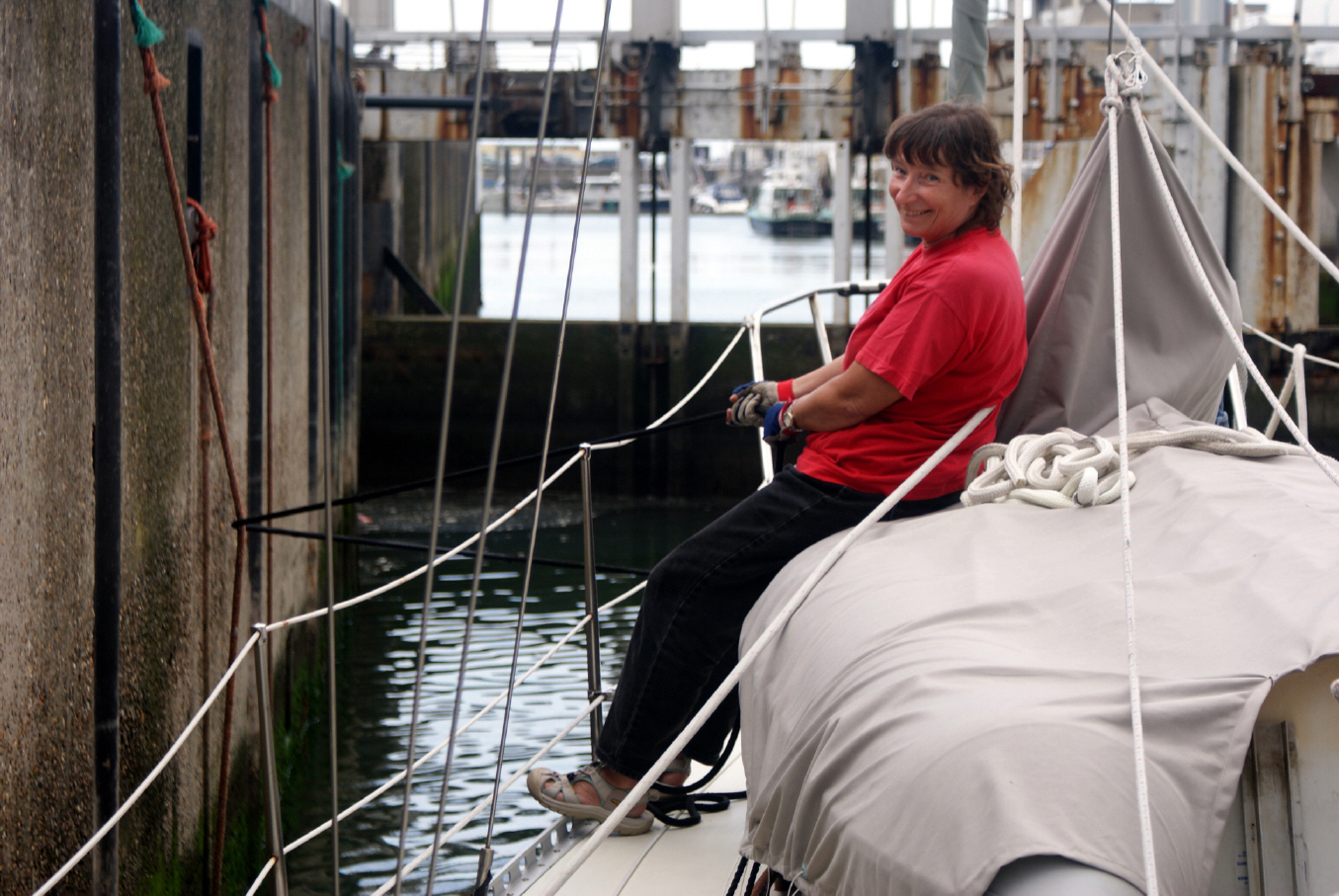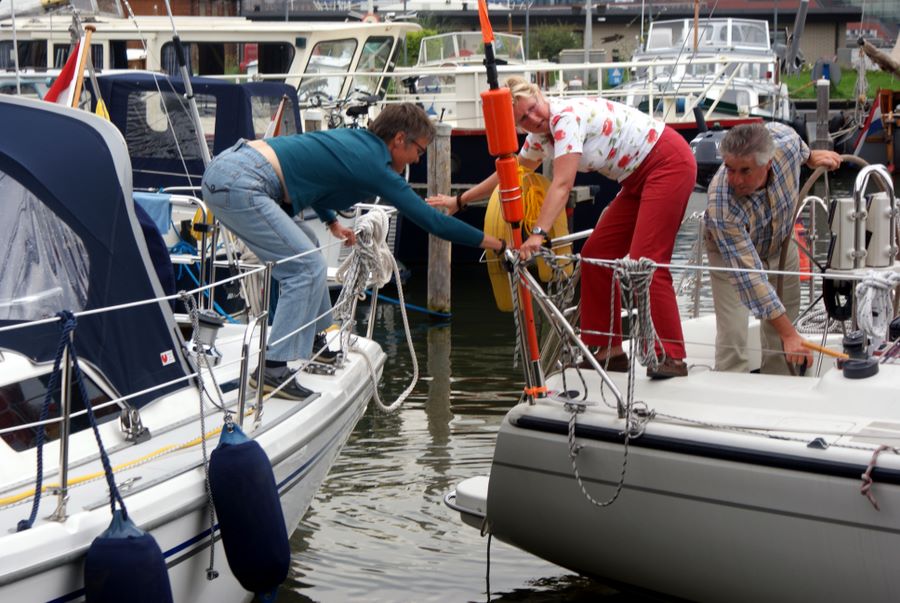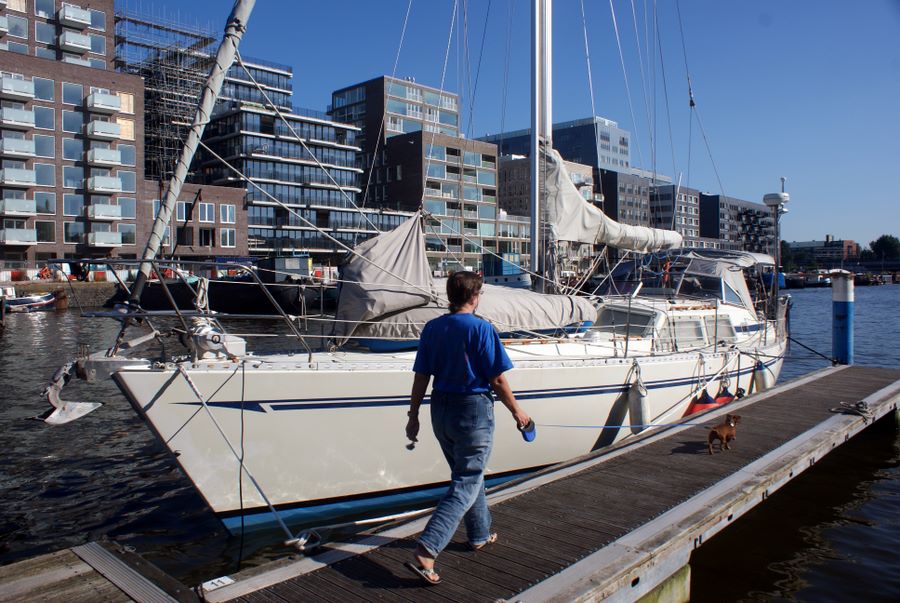Letter published in SSCA Commodores' Bulletin, December 2009
Cherbourg to Amsterdam
On our 14th day out from Horta, Azores, we docked at Cherbourg, France. The passage was largely uneventful for us with very light wind. We were just ahead of a gale system that plagued other cruisers in late July. With our small boat dog aboard, we have to stick to the continental, foreign-pet-friendly side of the English Channel (la Manche in French), so Cherbourg was our destination as others headed to Falmouth. (With proper documentation, you can bring pets into the U.K. without quarantine now, but you can't do this on your own boat. You must arrive via an approved carrier. See the U.K. pet procedures site for current details.)
Charts and books
We have a Raymarine chart-plotter that uses Navionics Gold series electronic charts. As backup we carry 2/3-sized, black-and-white charts from Bellingham Chart Printers. The port reference/sailing guides that we used for this voyage are The Shell Channel Pilot by Tom Cunliffe and Reeds Nautical Almanac from Adlard Coles Nautical. The former is a useful and beautiful book worthy of a coffee table, and the latter is subtitled The Yachtsman's Bible, and we've found to be worthy of that name.
Cherbourg, France
Cherbourg has one of the few all-weather, all-tide harbors on the north coast of France. (That's why it was so important to both sides in WWII.) Its entrance is easy, it's a port of entry, and the town is relatively large with good services and provisioning. All of these factors contributed to our decision to make it our first continental European landfall. We thoroughly enjoyed our stay there and plan to visit again on our way back out the channel.
We stayed at the Chantereyne Marina (email capitainerie@ville-chergourg.fr, phone +33 (0)2 33 87 65 70, VHF channel 09), which is the only real marina option in Cherbourg. There are four long docks for visitors to port as you enter the marina, plus a detached pontoon where boats wait until a space opens on one of the docks. It's first-come for space, but we called on VHF for instructions. In retrospect, that was a bit of a mistake. They put us in a slip on the other side of the marina, away from the other visitors, so we missed any cruiser camaraderie that might have been going on, but we did get the benefit of local knowledge from a British couple who live-aboard on the same dock. Reeds cited marina rates of €2.47/meter, which is approximately what we paid. That seems high to us now, but it's much less expensive than the south coast of England and includes electricity, water and wireless Internet, things we no longer assume are included.
For longer stays, the Bassin de Commerce is also a possibility. To get to it, you have to enter through a gate and a swing bridge, and facilities are limited. There is also an anchorage area between the marina and the navy base.
Cherbourg has lots of restaurants and several museums, including an excellent maritime museum La Cité de la Mer (City of the Sea), and it's in a great location for exploring the D-Day sites, war museums and other cultural attractions of Normandy. For trips outside of Cherbourg, it seems best to rent a car. Trains are relatively expensive, and bus service was complicated and not a bargain. We were planning to rent a car ourselves when our new British friends offered to take us to the Normandy American Cemetery at Omaha Beach and to the medieval city of Bayeux.
Restaurants seemed expensive to us, even before the economic crisis decimated our cruising budget. The least expensive plat du jour we saw ran €6. Excellent soft cheese, ham and wine were inexpensive, though, as were the baguettes. We bought a fresh baguette every day at different bakeries until we found the one we thought was the best. The Carrefour supermarket is within walking distance for major provisioning, and there's a liquor store at the marina.
The staffs of the marina and nearby stores speak enough English to do business. Shopkeepers were also patient with our attempts to speak French, however poorly.
The marina staff we talked with knew nothing about procedures for clearing in and directed us to the offices of the coast guard and Customs. There no one spoke more than a few words of English, and they seemed confused about why we were there if we had nothing to declare. Nonetheless, they made an appointment to inspect our boat, and we had a fairly thorough search the next day by Customs. (Dandelion, another SSCA'er who arrived after us having sailed non-stop from New York, did find a port captain to do his check-in, but we didn't get details.)
Nieuwpoort, Belgium
Because we wanted to reach Amsterdam before the end of August, we decided to skip other stops in France and headed for Nieuwpoort, Belgium. The traffic around Calais was very thick, and the seas at the point were short and bumpy, but that was nothing compared to threading our way through the narrow channel in front of Dunkerque (Dunkirk) in the dark. The channel markers are lighted, but they are very difficult to see against the bright lights of the refineries onshore, and there is commercial traffic even in the middle of the night.
In Nieuwpoort we stayed at the VVW-N marina for two nights (email info@vvwnieuwpoort.be, phone +32 (0)58-23 52 32), but we never felt particularly welcomed by the staff there. Upon our arrival a local charter captain suggested that we would like Ostend better, but after a couple of nights at sea we decided to stay one night to see for ourselves. We stayed a second night due to weather.
Nieuwpoort itself is a small town that suffered major damage in WWI. It's a bit of a hike to get there from the marina, and we didn't find a regular grocery store there. The marina does let you use their bicycles for free for a short time, so it's easy to take a bike to the supermarket in Lombardsijde, the opposite direction from Nieuwpoort. While we were there, we chanced upon an open-air art fair in Nieuwpoort and a Sunday neighborhood flea market/sidewalk sale in Lombardsijde, so all in all, we had a very nice time.
Ostend (Oostende), Belgium
In Belgium there are at least two spellings (Dutch and French) for almost every town, and most have three (something different for English). For example, the English spelling of this town is Ostend, Dutch is Oostende, and French is Ostende. Then there's Brussels/Brussel/Bruxelles (English/Dutch/French). Confusing?
Ostend is about 10 miles northeast of Nieuwpoort. We motor-sailed there and waited outside the entrance to the harbor for the green lights. The harbors here use International Port Traffic Signals. They look like huge traffic lights, but there are more color combinations. Here's a link to the combinations. When we arrived, the light was red for a ferry coming out plus a flotilla of really little sailboats for a children's regatta. Then it switched to green-white-green, which means you need permission to enter, so we called for permission. They said to wait. We had to wait through another red before we finally got our two greens.
The local captain in Nieuwpoort told us that when we went to Ostend, we should go to the Mercator Marina (phone +32 (0)59 70 57 62) because the surge at the Royal North Sea Yacht Club could be quite bad, so that's what we did. In order to get to the Mercator Marina, you must first clear the Mercator Locks and associated bridges; the lock schedule is on the marina website under Info. The fact that we would have to go through a lock to get here was one reason we'd picked Nieuwpoort instead to start out with, but we knew we would to have to do locks eventually, so we decided this was a good place to learn. And except for the crowds lining the lock walls watching us, it was. The short story is that we had some problems and got turned sideways in the lock, but we got straightened out again and learned from our mistakes. The major thing was that we didn't have our lines set up right, and the bowline got fouled, so we didn't get tied off quickly enough. When we left the lock and tied up to wait for the bridge to open, we did better.
Both the Mercator Marina and the Royal North Sea Yacht Club (RNSYC) are in downtown Ostend. Mercator is closer to the very nice, large grocery store, and a little closer to the train station, but the RNSYC has laundry facilities and gets more cruisers. We've spoken with cruisers who have had a great time at the RNSYC, including some who've had a great time despite sleepless nights in surge that snapped dock lines.
Ostend is a great location for visiting the rest of Belgium. Belgian trains are efficient and relatively inexpensive. The train station sells package excursions, and we bought a combination roundtrip to Brussels and entrance fees for two museums for less than the cost of the museums alone. We also bought a bus/coast tram package that allowed us to ride all buses in Flanders and the tram that runs along the coast. We had to work at it to get our money's worth out of this one because so much we wanted to see was within walking distance, but we did use it to take the bus to Bruges one day. It was a nice ride through the countryside, but when we discovered that one day wasn't enough to see Bruges, we took the train the second time.
Amsterdam, Netherlands
The standing-mast route through the south of the Netherlands to Amsterdam sounds like a lot of fun, but we were cruising to a deadline and running 50-50 on navigating locks, so we decided to sail to Ijmuiden to take the North Sea Canal to Amsterdam. The only tricky part of the passage is crossing the seaway to Rotterdam, and Rotterdam traffic control is a huge help with this. You're required to contact them anyway, and they tell you what the big guys are doing and what you're supposed to do, so it's very stress-free.
The same cannot be said of docking at Sixhaven. Sixhaven is the only marina in Amsterdam that most people have heard of. On the plus side, it's conveniently located across the IJ River from Amsterdam's Centraal Station, the train, tram and bus heart of the city, and a free ferry takes you across the river. It is also inside a security fence and quite safe. The negative is that the entrance and the entire dock area are very tight for larger boats without bow-thrusters. Bow-thrusters are common here even on 35-foot boats. For our heavy 46-footer (Panama Canal measurement) without a bow-thruster, it was agony. Still, with the help of some people on the dock, we man-handled Solstice to an end-tie from which we extended a couple of meters into the channel and went in search of the harbormaster for approval, which we received.
That afternoon we watched from the cockpit as the boats started arriving and trying to find slips in the already-full marina. When a Norwegian boat about our size came in, we encouraged them to raft up with us. We were happy to have them as a buffer as the bumper-boat games progressed. Our recommendation if you're planning to stay at Sixhaven is to be on your boat to fend off in the late afternoon as the newcomers arrive.
We spent the winter at Marina Westerdok (phone +31 (0)20 344 9434, email info@nauticadam.nl) across the IJ in the heart of Amsterdam. The marina has water and electricity on the dock, but no other facilities. It's behind a locked gate, but you must be sure to lock your dinghy, outboard and bike. Marina Westerdok is very conveniently located in the center of Amsterdam in the Jordaan neighborhood, but they are nearly unknown and you must go through two bridges to get there.
Another Amsterdam option if you want to avoid Sixhaven is Jachthaven Twellegea (phone +31 (0)20 632 0616), which is owned by the same company as Marina Westerdok. Twellegea is across the IJ from Amsterdam like Sixhaven, but you have to take bus 36 to get across the river to downtown. Twellegea has toilets and a shower, and perhaps laundry facilities, although we didn't see them when we visited. There is no supermarket nearby, but you can get everything you need from individual stores in the neighborhood. In contrast to Marina Westerdok's ultra-urban setting, the area around Twellegea feels like a village.
Customs and Immigration
Since we cleared into the E.U. in Horta, advice on the Cruisers Forum was not to worry about clearing in and out of individual Schengen countries; they'll find you if they want to talk with you. Since Cherbourg, we've found that to be true. We always tell the marina office that we're U.S. citizens on a U.S.-documented vessel and ask if Immigration or Customs need to be notified. No one ever knows. No one official contacted us in Belgium or so far in Denmark.
In the Netherlands, the Marechausee, a customs/coast guard hybrid had us pass our passports over to them on our way to Amsterdam in the North Sea Canal. Then they asked us a few questions and handed our passports back. When we were sailing from Harlingen to Terschelling in May, a couple of officers of the Marechausee boarded us (our first boarding at sea). Shirlee also cleared Customs and Immigration at Schiphol when returning from a trip to the U.S. These are the only officials we've dealt with since Cherbourg. None were concerned about how long we have been in the E.U. None gave us any paperwork (except for a receipt for the air/pellet gun that the Marechausee confiscated on our way to Terschelling) or asked for any beyond our passports. U.S. and Canadian citizens are not required to have a visa for a stay of up to 90 days as tourists, nor are they required to get a visa beyond that time, at least not in the Netherlands. Other Schengen countries may enforce the rather vague regulations differently. Some cruisers reported hassles returning to their boat in Sweden from the Olympics in China. Procedures may also be different in the Mediterranean. We are not recommending an approach to the formalities, merely reporting our experiences.
If any of you decide to follow in our wake, you will find that U.S. and Canadian boats are something of a rarity in this part of Europe. The most frequent questions we get are, "Are you really from San Francisco?" and "Did you sail all the way here on your own keel, just the two of you?" As much as we enjoy getting to know the local people, we (Shirlee especially) do miss the camaraderie of being with other cruisers. We will try to report this year's adventures more promptly.
Links to our photo pages from this leg of our voyage are below.
 France
France
 Belgium
Belgium
- Bruges (large page)
- Belfort of Bruges
- Canals of Bruges
- Fountain on 't Zand (Bruges)
- Market in Bruges
- St. Salvator Cathedral (Bruges)
- Gistel
- Nieuwpoort
- Ostend
 The Netherlands
The Netherlands
- Entering Holland
- Amsterdam photo pages:
- After dark
- Amsterdam (misc.)
- Bicycles
- Bridges
- Canal boating
- Markets
- North across the IJ
- Our neighborhood
- People
- Sixhaven
- Tourists
- Vondelpark
- Cruising with the van Gerwens
- Oeteldonk Intocht (Carnival in Den Bosch)
- Oeteldonk Optocht (Carnival in Den Bosch)

